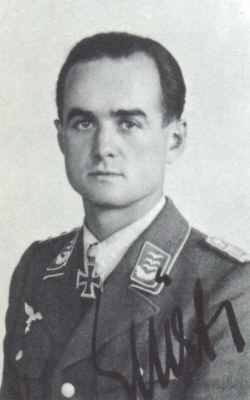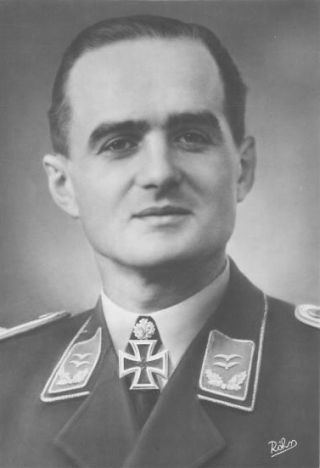Years of service 1939–451956–67 | Unit JG 54, JG 400, JG 7 Name Wolfgang Spate | |
 | ||
Born 8 September 1911Podersam, Sudetenland ( 1911-09-08 ) Rank | ||
Wolfgang Späte (8 September 1911 – 30 April 1997) was a German Luftwaffe fighter pilot during World War II. He was a recipient of the Knight's Cross of the Iron Cross with Oak Leaves, for the fighter pilots, it was a quantifiable measure of skill and combat success. He is attributed by some, for an early, 1938 version of the speed to fly theory, usually attributed to Paul MacCready. Already a talented glider pilot before the war, he went on to become one of the Luftwaffe's foremost test pilots.
Contents
Career

Späte was born on 8 September 1911 in Podersam. He participated in German invasion of the Balkans and Greece, he scored his first victory (a Yugoslav Bristol Blenheim, near Pecs in Hungary) on 7 April 1941. Returning to the eastern frontier for Operation Barbarossa, he shot down two SB-2 bombers on 23 June, the second day of the invasion. Victories came regularly, and he was awarded the Ehrenpokal, for 25 victories, on 9 August. Soon after, on 10 September, he was promoted to Staffelkapitän of 5./JG 54. Then on 5 October, he became the 10th member of JG 54 to be awarded the Ritterkreuz (Knight's Cross), after reaching 45 victories. His unit withdrew to the Reich at the end of the year for rest and refit, and Späte was promoted to Hauptmann on 1 January 1942. Success continued upon returning to the north of the Eastern Front as the Soviets desperately tried to raise the siege of Leningrad. This culminated with the award of the Oakleaves to the Knight's Cross on 23 April 1942 when he had 72 victories. However, with the award, he was ordered back to the Reich to set up a top-secret unit: Erprobungskommando 16, EKdo 16 - to test-fly the revolutionary new rocket-fighter, the Messerschmitt Me 163 "Komet".
Späte took his first flight in the Me 163 on 8 May 1942. Over the next year testing continued and slowly specially chosen pilots joined EKdo 16. Interestingly, side by side with the rocket-fighter project, was the test programme of the Me 262 jet-fighter (under EKdo 262). Späte first flew the Me 262 on 17 April 1943, and is one of a select few pilots to have flown both ground-breaking aircraft. After another year, the Me 163 was deemed combat-ready, and the testing program was wound down. Späte was promoted to Major and sent back to command a combat unit: IV./JG 54, currently based in Romania. Before he left for his new posting though, on 14 May 1944 he flew the first combat sortie for the Me 163. According to some sources, his Me 163 PK+QL was painted red, either in the factory or by ground crew, resembling Manfred von Richthofen's Fokker Dr.I. Although he flew the mission (without success, twice unable to intercept the evemy when the rocket engine failed), Späte was not amused after seeing the plane and ordered it to be re-painted.
His new unit was quickly recalled to Germany in June to cover the transfer of all the squadrons sent west following the D-day landings. There it was converted onto the Fw 190A-8 and then sent to Poland against the great Russian summer offensive. But against vastly greater numbers of enemy aircraft the unit was butchered, losing nearly half its pilots killed or wounded - Späte himself was injured and forced to bail out of his aircraft. The unit was pulled back again to the Reich for refit and rebuild. On 17 September, the Allied forces staged their airborne operation at Arnhem. Again, IV./JG 54 was thrown into the fray, but for the second time in less than 3 months, against vastly superior opposition, it was destroyed in less than a fortnight.
Whether due to problems getting the Me 163 operational, or his unit's catastrophic losses, Späte gave up his command of IV./JG 54. In his 4-month absence from the Me 163 programme, the first combat unit (I./JG 400) had been set up and he joined that unit to come back up to speed on the interceptor's progress (some sources say as the unit's commander, although Hptm Robert Olejnik is also given as the unit commander at this time).
In 1956 he rejoined the military service in the Bundeswehr. Späte retired in 1967. He died in 1997 in Edewecht, at the age of 85.
